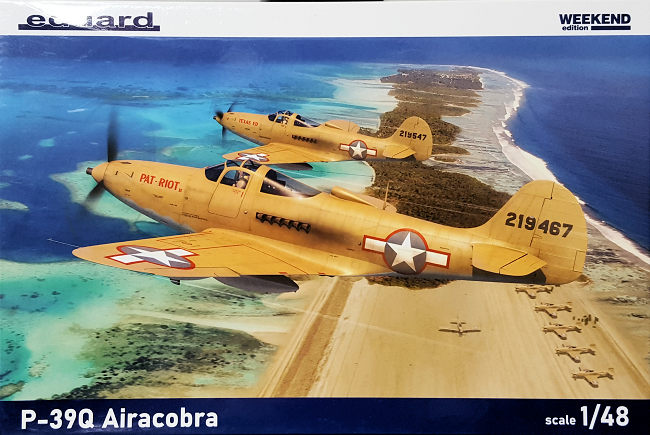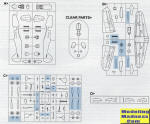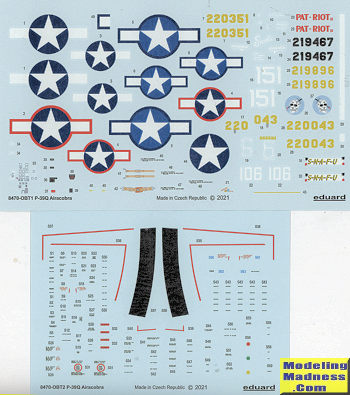
| KIT #: | 8470 |
| PRICE: | $25.00 |
| DECALS: | Four options |
| REVIEWER: | Scott Van Aken |
| NOTES: | Weekend Edition 2021 |

| HISTORY |
The Bell P-39 Airacobra was one of the principal American fighter aircraft in service when the United States entered World War II. The P-39 was used with great success by the Soviet Air Force, which scored the highest number of kills per pilot attributed to any U.S. fighter type. Other major users of the type include the Free French, the Royal Air Force, the United States Army Air Forces, and Co-belligerent Italian Air Force.
Designed by Bell Aircraft, it had an innovative layout, with the engine installed in the center fuselage, behind the pilot, and driving a tractor propeller via a long shaft. It was also the first fighter fitted with a tricycle undercarriage. Although its mid-engine placement was innovative, the P-39 design was handicapped by the absence of an efficient turbo-supercharger, limiting it to low-altitude work. Together with the derivative P-63 Kingcobra, the P-39 was one of the most successful fixed-wing aircraft manufactured by Bell.
In September 1940, Britain ordered 386 P-39Ds (Model 14), with a 20 mm (.79 in) Hispano-Suiza HS.404 and six .303 in (7.7 mm), instead of a 37 mm (1.46 in) cannon and six 0.30 in (7.62 in) guns. The RAF eventually ordered a total of 675 P-39s. However, after the first Airacobras arrived at 601 Squadron RAF in September 1941, they were promptly recognized as having an inadequate rate of climb and performance at altitude for Western European conditions. Only 80 were adopted, all of them with 601 Squadron. Britain transferred about 200 P-39s to the Soviet Union.
Another 200 examples intended for the RAF were taken up by the USAAF after the attack on Pearl Harbor as the P-400, and were sent to the Fifth Air Force in Australia, for service in the South West Pacific Theatre.
By the time of the Pearl Harbor attack, nearly 600 P-39s had been built. When P-39 production ended in August 1944, Bell had built 9,558 Airacobras, of which 4,773 (mostly −39N and −39Q) were sent to the Soviet Union through the Lend-Lease program. There were numerous minor variations in engine, propeller, and armament, but no major structural changes in production types, excepting a few two-seat TP-39F and RP-39Q trainers. In addition, seven went to the U.S. Navy as radio-controlled drones.
| THE KIT |
 Eduard's
P-39 was first released 25 years ago and was probably the first really modern
kit that the company produced. So popular is it that it has been reissued over a
dozen times both as a profipak kit and as part of their weekend edition series.
This is a weekend edition version and shows how much even this series has grown.
Initially weekend kits had one marking option and had the decal placement and
painting guide on the sides of the box.
Eduard's
P-39 was first released 25 years ago and was probably the first really modern
kit that the company produced. So popular is it that it has been reissued over a
dozen times both as a profipak kit and as part of their weekend edition series.
This is a weekend edition version and shows how much even this series has grown.
Initially weekend kits had one marking option and had the decal placement and
painting guide on the sides of the box.
The plastic has not changed at all and if you have good references, you will see that pretty much any P-39 variant can be built using what is available on the sprues. The kit is not a complex one to build. One of the interesting features is that the side doors are clear plastic so you only have to mask the clear part prior to painting. The kit provides decals for the seat harness and there is a lot of room in the nose for weight. While no amount of weight is recommended, I'd put in as much as you can fit. The kit also provides both weighted and unweighted tires. The Q variant has underwing gun pods for which you need to open holes in the lower wings.
 One of the
biggest improvements compared to the old weekend kit is a full color instruction
sheet and the provision of four markings options. Three of these are in OD over
neutral grey. The box art plane is the exception in sand over a light blue with
the 46th FS based on Kanton Atoll in 1943. Then there is Lt Shomo's white tailed
82PRS plane. A red tailed version from the 363rd FS based in the US is next and
finally a 70 FS plane based on Torokina in the Solomons in 1943 is provided.
Decals are nicely done and you are provided a full stencil suite. There are a
number of aftermarket decals for this plane if you decide to go that route.
One of the
biggest improvements compared to the old weekend kit is a full color instruction
sheet and the provision of four markings options. Three of these are in OD over
neutral grey. The box art plane is the exception in sand over a light blue with
the 46th FS based on Kanton Atoll in 1943. Then there is Lt Shomo's white tailed
82PRS plane. A red tailed version from the 363rd FS based in the US is next and
finally a 70 FS plane based on Torokina in the Solomons in 1943 is provided.
Decals are nicely done and you are provided a full stencil suite. There are a
number of aftermarket decals for this plane if you decide to go that route.
| CONCLUSIONS |
For many modelers, this qualifies as an 'old kit'. It is still very nice and is the 'go to' kit for many who want a nice P-39. There is lots of aftermarket out there for it as well.
January 2024
Copyright ModelingMadness.com. All rights reserved. No reproduction in
part or in whole without express permission from the editor.
If you would like your product reviewed fairly and fairly quickly, please
contact
the editor or see other details in the
Note to
Contributors. Back to the Main Page
Back to the Review
Index Page
Back to the Previews Index Page